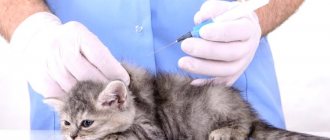Country and world August 27, 2018
“A year ago, we took a kitten from the street - small, defenseless, touching. They washed him, showed him to a veterinarian, and gave him vaccinations. Everything was fine until the boy grew up. And then the problems began. At first the cat began marking all over the house. Then “display arias” on the window. At the home council, they decided to fight the call of nature surgically. We just don’t know what is better to choose for an animal – castration or sterilization? They say these are different methods.” Natalya Savelyeva
Illustration pixabay.com
- It's really so
, says Oksana Listova, a surgeon at one of the veterinary clinics.
— Many people believe that the difference between castration and sterilization of animals lies in their differences in gender.
Castration is for males, sterilization is for females. In fact, sterilization is a surgical procedure applicable to individuals of both sexes. Only females have their fallopian tubes tied, and males have their testes tied. Scientifically, this operation is called a “vasectomy.” This operation is carried out only to deprive the animal of the opportunity to reproduce, but does not eliminate the causes of sexuality, and therefore is categorically not suitable for solving the problem of the “March cat”.
Castration is an operation in which the complete removal of organs responsible for the reproduction of animals occurs. During castration, the ovaries are removed along with the uterus in cats and female dogs (the operation is called “ovariohysterectomy”), and in male cats and dogs, the testes are removed.
Animals can be castrated starting at four months of age. But, for example, it is better to castrate dogs only by laparoscopic method, regardless of size and breed, even if the animal weighs 1.5 - 2 kg. This method causes less trauma to the abdominal wall and significantly shortens the recovery period. On the third day, the animal feels well and does not need any antibiotics or painkillers. And the intradermal sutures dissolve on their own.
But for cats, laparoscopic castration is not necessary - the uterus can be removed through a small hole during abdominal surgery.
#cats #question to the editor #health
The material was published in the newspaper “St. Petersburg Vedomosti” No. 156 (6255) dated August 27, 2018 under the title “Harmony instead of hormones.”
Share on VKontakte Facebook
Cool
The procedure for castration of cats
Surgical castration of a cat is recommended before the age of one year, when the animal’s genitals have not yet fully formed and there is no sexual desire. This will eliminate severe stress and minimize the risk of complications. Postoperative wounds in kittens heal faster than in adult cats.
Neutering a cat provides several benefits:
- the pet becomes more affectionate and calm;
- the cat does not “mark” the house;
- the likelihood of escapes and long-term disappearances is reduced.
The lack of sexual desire eliminates the discomfort that a pet’s heart-rending screams create at night. The cat does not run away from home, does not communicate with stray animals, and the risk of contracting infectious diseases is eliminated.
There are contraindications to castration. Such operations should not be performed on sick, weakened animals, or during periods of exacerbation of chronic diseases. Castration is performed under anesthesia. If the cat has an individual intolerance to anesthetics, the operation cannot be performed.
Pet owners should follow all recommendations for preparation for castration and care during the rehabilitation period. This will eliminate the risk of complications and ensure rapid wound healing.
Preparing for surgery
Despite the difference between sterilization and castration operations, the preparation measures for the procedure are no different:
- Vaccination. Vaccinations against infectious diseases are given 2-4 weeks before surgery. If the operation is performed in a clinic, the risk of infection from someone else's animal is minimized. At home, vaccine-enhanced immunity will help avoid possible complications due to incomplete sterility. If the procedure needs to be done urgently, hyperimmune serum is injected.
- Preliminary inspection. The operation will reduce immunity, so the cat should not have any ailments. It is also advisable to carry out antiparasitic treatment.
- Mandatory food restriction. Anesthetic drugs may cause vomiting. 12 hours before the expected time of surgery, you should not feed your pet, and 2-3 hours before the procedure, even water should be excluded from the diet.
Cat sterilization operation
There are many reasons why cat owners turn to veterinarians to have their cats sterilized. The main argument is the reluctance to take care of cat offspring and place babies. But there are other positive consequences of such an operation. Neutered cat:
- has a calm, easy-going character;
- does not try to escape into the street;
- does not create discomfort by screaming at night and inappropriate behavior;
- does not communicate with stray animals, the risk of infections is eliminated.
During the operation, the tubes through which the eggs travel can be ligated, and the ovaries can be removed. The uterus remains during sterilization. Some owners prefer castration. In this operation, all reproductive organs are removed from the cat. This eliminates the risk of serious uterine diseases.
Surgical sterilization of a cat is a more traumatic operation than castration of a cat. But following the rules of postoperative care eliminates the risk of complications. The optimal age for sterilization of an animal is 7-8 months.
What is the difference?
So, during castration , the gonads are completely removed from the animal’s body (for males, the testes, and for females, the ovaries), as a result of which the pet is provided with complete sexual rest for the rest of its life. After the operation, the animal will not have any desires and needs, as well as the ability to engage in full sexual activity.
But sterilization , in turn, is rarely used in veterinary medicine for small pets, as it involves ligating (that is, ligating or soldering) the spermatic cords in cats and the oviducts in cats. After such an intervention, animals lose the ability to reproduce, while maintaining sexual activity, since sex hormones continue to be synthesized in their gonads. So it turns out that from the point of view of the health of the animal and the convenience of life for household members, sterilization of cats and female cats does not make sense at all, because all the nuances of their sexual behavior remain unchanged (increased activity, screaming, aggressiveness, etc., etc.) .
Technically, an operation to sterilize domestic cats is quite possible, but it is usually used for medical reasons in the treatment of some diseases.
Moral and physiological arguments against
The main argument of opponents of sterilization and castration is the belief that depriving animals of the opportunity to procreate is inhumane. They believe that a cat has the right to motherhood and should not be deprived of this happiness. But we should not transfer human feelings to animals and attribute our experiences to them. In addition, a cat or cat that is sterilized at an early age is completely unaware of suffering and regret. They have not experienced sexual desire and are not aware of its existence.
Some owners refuse to spay or neuter their pet for fear of harming its health. It is known that after such operations there is a real risk of obesity, diabetes, and disorders in the functions of other organs. However, there is a way to avoid such problems. To do this, you must strictly follow the rules of feeding castrated and sterilized animals. Their diet differs from the standard menu.
Castration of a cat
In cats, the entire castration process is more complicated, since the operation in this case is abdominal, that is, the uterus and ovaries are removed through a deep incision in the groin or abdomen. Surgical manipulations last 30-40 minutes, after which the wound is sutured, and the animal is dressed in a special blanket or collar that prevents the seam from licking and scratching.
It is worth noting that females can be castrated not only in the standard way, but also endoscopically - when several small incisions are made on the abdominal wall, through which endoscopic instruments and a camera with a light are inserted. The surgeon controls all his actions through a display that displays an image of the operation progress. But such an operation, of course, will cost more.
Recovery after surgery depends on the individual characteristics of the body of a particular animal, which is why it can take different times. As a rule, after anesthesia, cats and cats leave within 2-4 hours, and fully come to their senses after about one day.
Consequences of refusing to sterilize a cat
Owners who refuse to sterilize their beloved cat will have to choose one of three options:
- give the animal special drugs to suppress sexual desire;
- patiently endure periods of “desire”;
- provide the animal with complete freedom.
Special drops and tablets help suppress sexual desire. Please note that these are hormonal drugs. Taking them can have a negative impact on the cat’s body. The most common consequence of using such drugs is a malignant tumor.
Not all owners can calmly survive periodic changes in the character of the animal. The most unpleasant moment is the pet's heart-rending screams at night. These heartbreaking sounds disturb not only the cat's owners, but also their neighbors, which creates additional problems.
Giving the cat complete freedom is not the best option. She can become a mother as early as six months, when her body is not yet fully formed. Then a healthy animal can kitten two or three times a year. Finding homes for kittens of popular, rare breeds is not too difficult. But mongrel babies can create a lot of problems.
It is no secret that many cat owners do not complicate their lives and immediately kill their newborn offspring. Such actions should not even be discussed. If it is inhumane to deprive a cat of the opportunity to procreate, then destroying born kittens is completely inhumane.
At what age is surgery recommended?
It is better to do the operation before the pet reaches puberty. For cats, the optimal age is 7-9 months (preferably before the first mating), for a cat - 6-7 months (before the onset of estrus). The differences between castration and sterilization of cats do not affect the age permissible for surgery; You only need to take into account how strong the animal’s body is.
If the procedure is carried out earlier than the recommended age, the kitten owner may encounter problems with the animal's growth and development being delayed. Operational risks will also increase, since the kitten is not yet fully formed. If the operation is performed later, the risk of complications increases in proportion to the age of the animal. The older the animal, the harder the anesthesia is tolerated, the longer the recovery, and the higher the likelihood of postoperative complications.
If the pet is over 7 years old, then the doctor can play it safe: prescribe preliminary tests, conduct a heart examination.
For females there are additional indications. It is better to carry out the operation before the first birth, when sex hormones are produced only by the ovaries, and not by other endocrine glands. It is not recommended to carry out the procedure during estrus: the internal genital organs become filled with blood, which will complicate the operation. If the cat has already given birth, then it is better to postpone the operation for 2-3 weeks after stopping feeding the kittens. During pregnancy, hysterectomy is recommended only for medical reasons, as changes in hormonal levels and physiology will complicate the operation.
Russian problem of homeless animals
In every city and town you can see many stray cats. Most of these unfortunate animals are abandoned pets that were born after the cat was given complete freedom. There is no need to explain how difficult it is to live on the street. But animals manage not only to survive, but also to have offspring. Therefore, the number of stray cats is growing rapidly.
Street animals pose a threat to pets. They are often carriers of:
- worms,
- ticks,
- retroviruses,
- chronic runny nose,
- eye diseases, etc.
Supporters of castration and sterilization consider refusal of these operations to be irresponsible. If the consequence of such a decision is to increase the army of stray cats, these accusations are well founded.
Much attention is now being paid to solving this issue. Shelters are organized for homeless animals, and sterilization and castration campaigns are held for street cats and female cats. But this does not mean that the problem will be solved in the near future. Is it worth complicating it by justifying the refusal of sterilization on moral principles?
Postoperative care
Care after sterilization depends on the sex of the animal. In females, abdominal surgery is performed, stitches are applied, and the body recovers for 2-3 days. In males, the wound is shallow and heals faster; health returns to normal the very next day.
Care stages:
- Place in a safe, warm place. Under anesthesia, thermoregulation is disrupted, and the cat needs additional warmth. Coordination of movements is temporarily impaired: it is necessary to protect the animal from injury when it wakes up and tries to get up.
- Lay down a waterproof bedding or absorbent diaper: when recovering from anesthesia, involuntary urination is possible.
- Take care of your eyes. Cats under anesthesia do not close their eyes. To avoid postoperative conjunctivitis, you need to periodically instill saline into the eyes or close the animal’s eyelids every 5-10 minutes.
- Do not feed during recovery from anesthesia. Due to a violation of the swallowing reflex, only water can be given to a cat for the first 12 hours, to a cat for 24 hours.
- Protect stitches or wound. The male does not require special care for the wound; in case of scratching, a special collar can be worn. The female should wear a blanket or bandage for 7-10 days until the stitches are removed and 1-2 days until the final healing. If the wound becomes wet or festered, the surgical area is treated with an alcohol-free antiseptic. During the first 2-3 days, tissue swelling is allowed.
- Follow the veterinarian's recommendations. The animal may be prescribed additional antibiotics and undergo an additional examination to prevent complications.
What is the difference between castration and sterilization?
Many people think that the difference between castration and sterilization is the gender of the animal undergoing the operation. Actually this is not true. You can castrate both a male and female cat. How do these concepts differ? And how does the life of animals and their owners change after such an operation?
Sterilization of an animal is limited to ligation of the fallopian tubes in females or ligation of the seminal ducts in males and females. Scientifically, this operation is called a vasectomy. After the procedure, the animal’s genitals remain; they continue to produce hormones and function as usual. Sterilization of both male and female animals does not affect sexual desire, their instincts do not decrease or lose their intensity. Animals can mate, but they cannot have offspring.
Castration is an operation in which the complete removal of organs responsible for the reproduction of animals occurs. When castrating cats and bitches (female dogs), the ovaries are removed along with the uterus (an operation called ovariohysterectomy) or only the ovaries (oophorectomy).
Previously, veterinarians only removed the ovaries of young cats that had not given birth. But now ovariohysterectomy is increasingly being performed, since recently gynecological problems are becoming more common even in young cats. In male cats, both testicles are removed during castration.
Castration or sterilization?
Sterilized animals, despite the absence of offspring, very often experience hormonal storms due to the fact that their reproductive system continues to function normally. This does not have the best effect on the animal’s body. Neutered cats and dogs are more likely to be stressed and, as a result, at risk of diseases of the genitourinary system. Such animals very often lose weight for no reason, refuse to eat and behave aggressively towards the owner.
In castrated animals, life expectancy increases by several years. It is among such animals that long-livers are found. In addition, this operation largely solves the behavior problem, since neutered cats do not scream or mark furniture. This also applies to male dogs, who mark every place in the house even more often than cats.
Castration almost completely eliminates the possibility of purulent inflammation, cysts or neoplasms in the genital organs of animals. Reduces to zero the likelihood of males and female cats getting prostatitis.
We emphasize that in adulthood, some animals need such an operation for medical reasons, so it is better to take action while the animal is full of vitality and energy, and therefore will tolerate anesthesia without any problems.
How to prepare an animal?
It is necessary not to feed the animal 8-12 hours (at least 6 hours) before surgery. Do not give drink for 4-6 hours. Otherwise, this will have a detrimental effect on the postoperative period, in addition, the animal’s condition may worsen after the administration of anesthesia.
How is castration performed?
The operation is performed under general anesthesia. The surgical field is prepared (hair is shaved, skin surface is disinfected). In male and female cats, the veterinarian shaves the scrotum, makes two small incisions, ties the spermatic cord and removes the testes.
The wounds are powdered with a complex powder - tricillin - in order to prevent postoperative complications. Postoperative sutures are usually not required to be removed. The entire operation lasts no more than five minutes.
In cats and bitches, an incision is made on the abdomen in the groin area and the ovaries and uterus are removed. The operation lasts on average 30 minutes. Then a suture is applied and a special bandage is put on to prevent the animal from licking or scratching the seam.
What to do after castration?
Castration in male and female cats does not require special postoperative care. The cat or male dog should be placed on the floor and covered with a waterproof diaper, as there is a high probability that he will wet himself. If the cat/dog has not yet fully recovered, make sure that he does not climb onto a hill from which he could fall.
As for a cat or bitch, the animal recovers from anesthesia within the first day, then it is necessary to treat the stitches for 10 days and prevent the stitches from licking. To do this, your pet must wear a special post-operative blanket or collar.
Once the sutures are removed, no other special care is required and the sutures are removed by a veterinarian. If you have experience, you can do it yourself by consulting with a specialist.
You can feed only after the animal has completely recovered from anesthesia.
After castration, the animal needs a diet aimed mainly at preventing obesity. Neutered animals have a slower metabolism. If an animal lives in an apartment, then, as a rule, it leads a sedentary lifestyle, which aggravates the situation. A pet’s poor heredity also plays an important role in metabolic disorders.
Pros of castration
The life expectancy of castrated animals is on average 1.5-2 years longer.
Neutered animals are calmer. The desire to run away disappears. Animals become more obedient and controllable.
All hormonal problems disappear. And you will stop suffering from howling and meowing at night, strong-smelling marks will no longer appear in your house.
Your pet will not suffer from such severe, common diseases as prostatitis, pyometra, cysts and neoplasms of the ovaries, uterus and testes.
In animals sterilized at a young age, the likelihood of hormone-dependent malignant mammary tumors almost disappears.
Remember
: animals are deprived of the ability to think logically, they are not tormented by remorse and regret about their inability to reproduce.
Disadvantages of castration
Castration is performed under general anesthesia, which is accompanied by a certain risk for the animal’s body, albeit low in a healthy, young animal, but still a risk. To minimize these risks, the veterinarian always checks the animal's health.
With any surgical intervention on the body there is a risk of complications. The higher the qualifications of the surgeon, the fewer complications, as a rule, occur.
Some obese bitches may develop urinary incontinence after sterilization, which, however, is easily relieved with special medications.
Remember
: castration is the most elementary of operations in veterinary practice and almost never causes complications. If the animal is young and healthy, castration will not bring any unpleasant surprises.
What to choose: castration or birth control pills?
The answer is clear - it is better to operate. This is due to the fact that all produced pharmacological drugs are designed to stop one or two heats. Their long-term use causes serious hormonal problems in the body and often leads to inflammatory diseases of the uterus.
Castration and urolithiasis
There is no direct relationship between castration and urolithiasis, and there is no confirmation of this fact in the scientific literature. This disease is also a consequence of impaired metabolism and is most often found in animals with excess body weight. Therefore, proper nutrition is the key to your cat’s health. This is why it is very important to approach feeding responsibly.
For castrated animals, there are special dietary foods that are sold in veterinary pharmacies and specialized pet stores. For questions regarding their correct use, you can always consult the seller. Your veterinarian will provide more detailed advice on feeding and maintaining your cat after surgery.
Castration and character change
The character of an animal changes for the better after castration. The animal stops marking its territory, howling, and meowing during estrus. In most cases, he becomes cheerful and cheerful, flexible and to some extent more disciplined.
Optimal age for castration
It is not recommended to castrate males younger than six months of age, as in this case they will lag behind in growth and development. The ideal age for a cat is 7-10 months.
It is better to sterilize females before their first heat (from 6 to 9 months) - this will almost certainly protect them from the development of mammary tumors.
Did you like the article? Share with friends:
What is better and safer for a cat: sterilization or castration?
Many veterinarians note that the procedures differ significantly from each other from a humane point of view. Castration is considered the most loyal method. Neutered animals live longer and better quality lives. After removal of their reproductive organs, their risk of developing serious diseases of the reproductive system and urinary tract is significantly reduced.
Spayed furry pets differ from neutered ones in that they experience strong hormonal surges. Due to the fact that the gonads do not stop their activity, the stressed body suffers additional shocks. Sterilized individuals often suffer from appetite disorders and are characterized by aggressive behavior.











